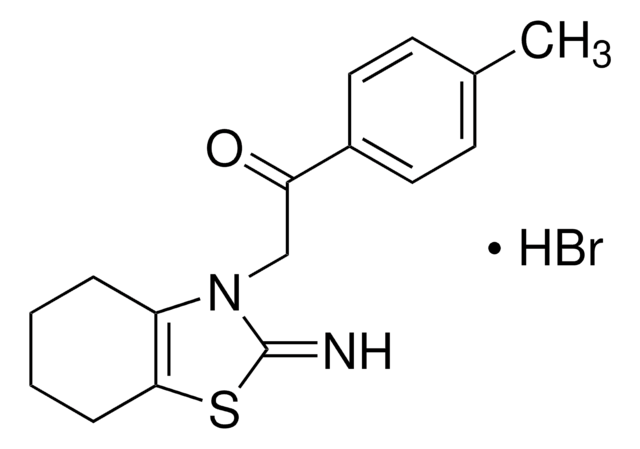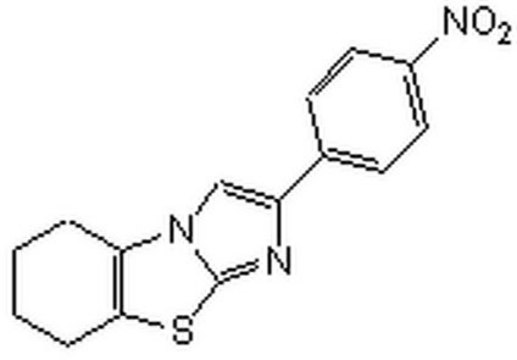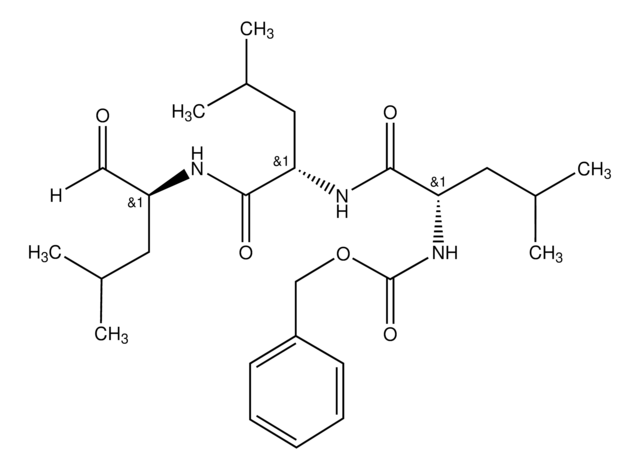506132
Pifithrin-α
≥95% (HPLC), solid, p53 inhibitor, Calbiochem®
Synonym(s):
Pifithrin-α, 2-(2-Imino-4,5,6,7-tetrahydrobenzothiazol-3-yl)-1- p-tolylethanone, HBr
Sign Into View Organizational & Contract Pricing
Select a Size
All Photos(1)
Select a Size
Change View
About This Item
Empirical Formula (Hill Notation):
C16H18N2OS · xHBr
CAS Number:
Molecular Weight:
286.39 (free base basis)
MDL number:
UNSPSC Code:
12352200
NACRES:
NA.77
Recommended Products
Product Name
Pifithrin-α, A cell-permeable chemical inhibitor of p53.
Quality Level
assay
≥95% (HPLC)
form
solid
manufacturer/tradename
Calbiochem®
storage condition
OK to freeze
protect from light
color
off-white
solubility
DMSO: 100 mg/mL
shipped in
ambient
storage temp.
−20°C
General description
A cell-permeable chemical inhibitor of p53. Reversibly inhibits p53-dependent transactivation of p53-responsive genes and reversibly blocks p53-mediated apoptosis. Inhibits p53-dependent growth arrest of human diploid fibroblasts in response to DNA damage but has no effect on p53-deficient fibroblasts. Protects normal tissues from the deleterious side effects of chemotherapy. Has been reported to protect neurons against β-amyloid peptide and glutamate-induced apoptosis.
A reversible inhibitor of p53-dependent transactivation of p53-responsive genes and reversibly blocks p53-mediated apoptosis. Inhibits p53-dependent growth arrest of human diploid fibroblasts in response to DNA damage but has no effect on p53-deficient fibroblasts. Protects mice from lethal genotoxic stress associated with anticancer treatment without promoting tumor formation. Has been reported to protect neurons against β-amyloid and glutamate-induced apoptosis.
Biochem/physiol Actions
Cell permeable: yes
Primary Target
PS3
PS3
Product does not compete with ATP.
Reversible: yes
Packaging
Packaged under inert gas
Warning
Toxicity: Standard Handling (A)
Reconstitution
Following reconstitution, aliquot into cold tubes and freeze (-20°C). Stock solutions in DMSO are stable for 3 months at -20°C. Unstable in aqueous solutions.
Other Notes
Murphy, P.J.M., et al. 2004. J. Biol. Chem.279, 30195.
Culmsee, C., et al. 2001. J. Neurochem.77, 220.
Komarova, E.A., and Gudkov, A.V. 2000. Biochemistry (Mosc.) 65, 41.
Stadler, P., et al. 2000. Strahlenther Onkol. 176, 98.
Ferber, D. 1999. Science 285, 1651.
Jacquemin-Sablon, A. 1999. Bull. Cancer86, 894.
Komarov, P.G., et al. 1999. Science 285, 1733.
Culmsee, C., et al. 2001. J. Neurochem.77, 220.
Komarova, E.A., and Gudkov, A.V. 2000. Biochemistry (Mosc.) 65, 41.
Stadler, P., et al. 2000. Strahlenther Onkol. 176, 98.
Ferber, D. 1999. Science 285, 1651.
Jacquemin-Sablon, A. 1999. Bull. Cancer86, 894.
Komarov, P.G., et al. 1999. Science 285, 1733.
Legal Information
CALBIOCHEM is a registered trademark of Merck KGaA, Darmstadt, Germany
Storage Class
11 - Combustible Solids
wgk_germany
WGK 3
flash_point_f
Not applicable
flash_point_c
Not applicable
Certificates of Analysis (COA)
Search for Certificates of Analysis (COA) by entering the products Lot/Batch Number. Lot and Batch Numbers can be found on a product’s label following the words ‘Lot’ or ‘Batch’.
Already Own This Product?
Find documentation for the products that you have recently purchased in the Document Library.
Roberta Gonnella et al.
Biology, 11(1) (2022-01-22)
We have previously shown that Zinc supplementation triggered ER stress/UPR in cancer cells undergoing treatment by genotoxic agents, reactivated wtp53 in cancer cells harboring mutant p53 (mutp53) and potentiated the activity of wtp53 in those carrying wtp53. In this study
Amena BenYounès et al.
Autophagy, 7(8), 883-891 (2011-04-05)
Autophagic flux can be measured by determining the declining abundance of autophagic substrates such as sequestosome 1 (SQSTM1, better known as p62), which is sequestered in autophagosomes upon its direct interaction with LC3. However, the total amount of p62 results
Chun-Hao Su et al.
iScience, 24(11), 103368-103368 (2021-11-25)
Thrombocytopenia-absent radius (TAR) syndrome is caused by RBM8A insufficiency. We generated megakaryocyte-specific Rbm8a knockout (Rbm8aKOMK) mice that exhibited marked thrombocytopenia, internal hemorrhage, and splenomegaly, providing evidence that genetic deficiency of Rbm8a causes a disorder of platelet production. Rbm8aKOMK mice accumulated
Our team of scientists has experience in all areas of research including Life Science, Material Science, Chemical Synthesis, Chromatography, Analytical and many others.
Contact Technical Service








